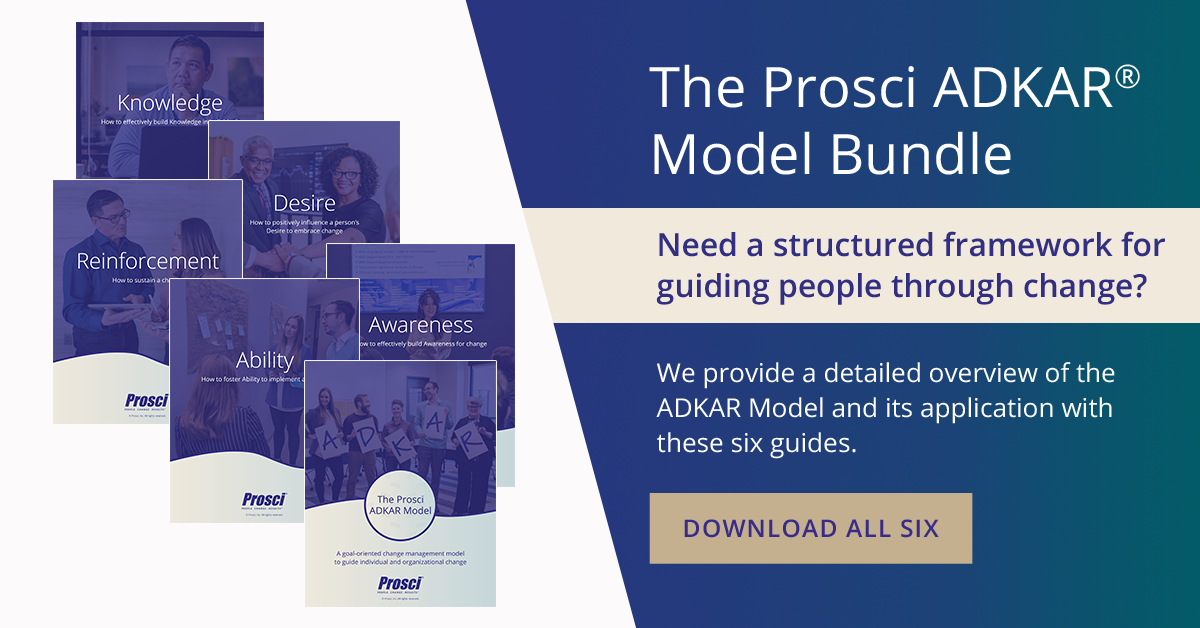You have no items in your shopping cart.
Desire - The Prosci ADKAR Model

2 Mins
Updated: May 10, 2024
Published: September 4, 2018

Once an individual has an understanding of why a change is needed, the next step in successful change is making a personal decision to support and participate in the change. This is the second milestone of the Prosci ADKAR® Model, a simple but effective model for individual change made up of five building blocks of change:
- Awareness
- Desire
- Knowledge
- Ability
- Reinforcement®
While we know that an individual must decide to support a change, achieving this seemingly simple milestone is not as easy as it sounds. In fact, some of the greatest challenges for change management professionals lie within this element of the ADKAR model. Learn why desire requires a carefully architected change management strategy in order for your changes to succeed below.
Making the Transition from Awareness to Desire
More and more and more awareness does not result in desire. Continuing to focus on the reasons for change and not translating those reasons into the personal and organizational motivating factors is a trap some change management practitioners face, and it can be very discouraging and annoying for employees. Your change management plans will require artful use of key business leaders as sponsors of change, and of managers and supervisors as coaches to employees during the change process.
Motivators for Participating in a Change:
- Likelihood of gain or achievement (incentive)
- Fear of consequence (risk or penalty)
- Desire to be part of something (to belong)
- Willingness to follow a leader you trust
- Alternative is worse
Succeed with the ADKAR eBook Bundle
Explore the five building blocks that make up the ADKAR Model in greater detail and learn how they can help you elevate change success in your organization.
How to Achieve Desire
Many practitioners say that desire is the most difficult of the five building blocks to achieve. Desire is difficult because it is ultimately a personal decision that is not under our direct control. While there are certainly ways to try and influence a person's decision to embrace a change, in the end individuals must make this decision themselves. As with awareness, desire is only achieved when the individual says to us, "I will be part of this change."
Tactics for Building Desire:
- Active and visible primary sponsor
- Strong sponsorship coalition
- Personal engagement by coaches
- Proactive management of resistance
- Strong employee involvement in creating the needed solution
- Incentive programs aligned with the change
Potential Resisting Factors:
- Comfort or security with how things are now
- Fear of the unknown
- Change not aligned with a person's self-interest or values
- No answer to What's In It For Me? (WIIFM)
- Negative history with change on a personal level (low confidence of success)
- An individual’s personal situation - financial, career, family, health
- An organization's track record with change
Awareness and desire, the first two elements of ADKAR, can ebb and flow. Sometimes, change management professionals will conclude that once they have created awareness and desire, they no longer need to reinforce these elements. They quickly move on to training to help build knowledge and ability. However, in reality, awareness and desire can go away as quickly as they were created. It requires reinforcement and continued communication to maintain the levels of awareness and desire necessary to make changes successful.


